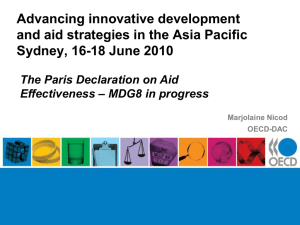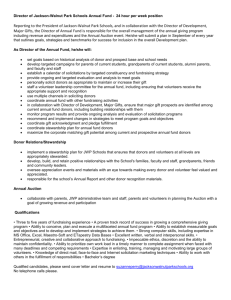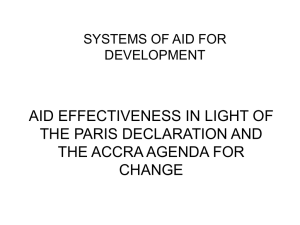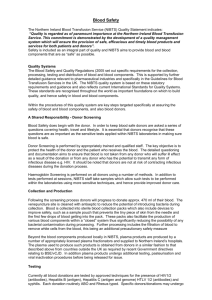Obstacles to achieving Paris Declaration targets
advertisement
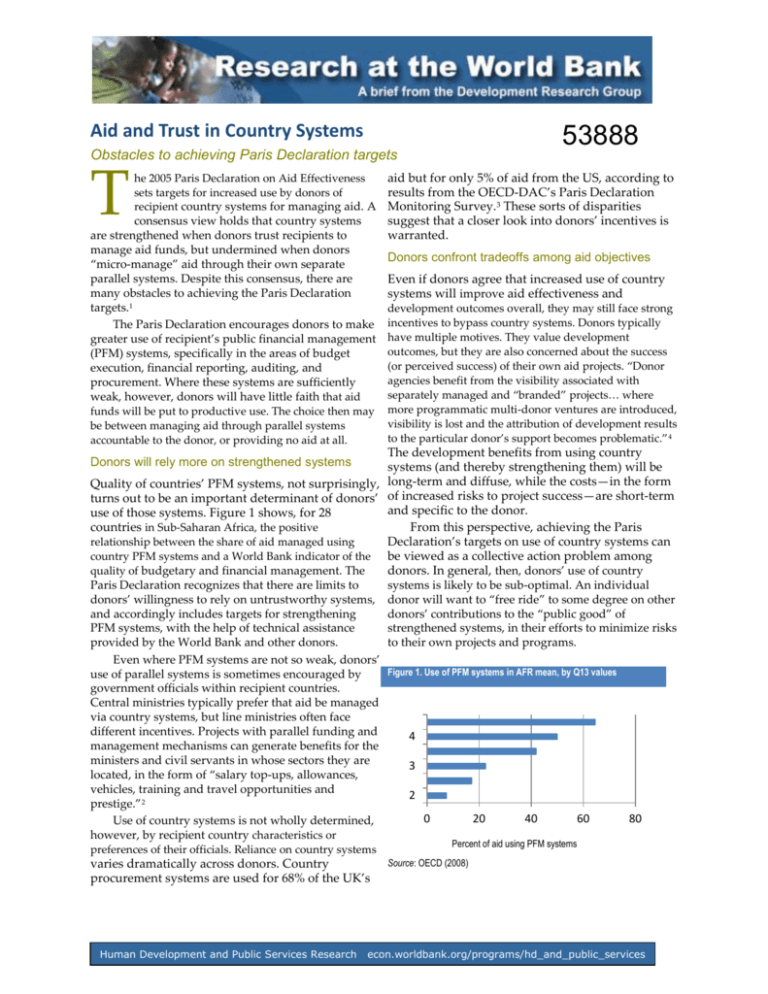
Aid and Trust in Country Systems 53888 Obstacles to achieving Paris Declaration targets T he 2005 Paris Declaration on Aid Effectiveness sets targets for increased use by donors of recipient country systems for managing aid. A consensus view holds that country systems are strengthened when donors trust recipients to manage aid funds, but undermined when donors “micro-manage” aid through their own separate parallel systems. Despite this consensus, there are many obstacles to achieving the Paris Declaration targets.1 The Paris Declaration encourages donors to make greater use of recipient’s public financial management (PFM) systems, specifically in the areas of budget execution, financial reporting, auditing, and procurement. Where these systems are sufficiently weak, however, donors will have little faith that aid funds will be put to productive use. The choice then may be between managing aid through parallel systems accountable to the donor, or providing no aid at all. aid but for only 5% of aid from the US, according to results from the OECD-DAC’s Paris Declaration Monitoring Survey.3 These sorts of disparities suggest that a closer look into donors’ incentives is warranted. Donors confront tradeoffs among aid objectives Even if donors agree that increased use of country systems will improve aid effectiveness and development outcomes overall, they may still face strong incentives to bypass country systems. Donors typically have multiple motives. They value development outcomes, but they are also concerned about the success (or perceived success) of their own aid projects. “Donor agencies benefit from the visibility associated with separately managed and “branded” projects… where more programmatic multi-donor ventures are introduced, visibility is lost and the attribution of development results to the particular donor’s support becomes problematic.” 4 The development benefits from using country systems (and thereby strengthening them) will be Quality of countries’ PFM systems, not surprisingly, long-term and diffuse, while the costs—in the form turns out to be an important determinant of donors’ of increased risks to project success—are short-term and specific to the donor. use of those systems. Figure 1 shows, for 28 countries in Sub-Saharan Africa, the positive From this perspective, achieving the Paris relationship between the share of aid managed using Declaration’s targets on use of country systems can country PFM systems and a World Bank indicator of the be viewed as a collective action problem among quality of budgetary and financial management. The donors. In general, then, donors’ use of country Paris Declaration recognizes that there are limits to systems is likely to be sub-optimal. An individual donors’ willingness to rely on untrustworthy systems, donor will want to “free ride” to some degree on other and accordingly includes targets for strengthening donors’ contributions to the “public good” of PFM systems, with the help of technical assistance strengthened systems, in their efforts to minimize risks provided by the World Bank and other donors. to their own projects and programs. Even where PFM systems are not so weak, donors’ Figure 1. Use of PFM systems in AFR mean, by Q13 values use of parallel systems is sometimes encouraged by government officials within recipient countries. Central ministries typically prefer that aid be managed via country systems, but line ministries often face different incentives. Projects with parallel funding and 4 management mechanisms can generate benefits for the ministers and civil servants in whose sectors they are 3 located, in the form of “salary top-ups, allowances, vehicles, training and travel opportunities and 2 prestige.”2 0 20 40 60 80 Use of country systems is not wholly determined, however, by recipient country characteristics or Donors will rely more on strengthened systems preferences of their officials. Reliance on country systems varies dramatically across donors. Country procurement systems are used for 68% of the UK’s Human Development and Public Services Research Percent of aid using PFM systems Source: OECD (2008) econ.worldbank.org/programs/hd_and_public_services Figure 2. Use of PFM systems in public support for aid rely more on country systems in managing its aid where it accounts for a larger share of the recipient’s total aid. Providing a large share of a recipient’s aid is not the only factor that may raise a donor’s reputational or other stakes in a country’s long-term development. Other things equal, a bilateral donor may be more willing to invest in the long-run development of its former colonies, and its geographic neighbors. Data analysis shows that donors’ reliance on country systems increases with geographic proximity of recipient countries, but is no higher in former colonies. Implications for donors Reducing aid fragmentation is commonly advocated as a means of reducing transactions costs imposed on recipients. Results summarized here As noted above, however, some donors “free ride” suggest it would also increase use of country systems. in this sense much more than others. Moreover, use of Sharper division of labor geographically may be country systems varies across recipients for a given donor, to a greater degree than can be attributed to politically difficult for some donors. But many of the benefits from reduced fragmentation may apply at the differences in quality of their PFM systems. How sector level. Even with many donors in a country, can these variations in donor behavior be sectoral division of labor can increase a donor’s explained? reputational stake in the success of a given sector, such Donors differ in their mandates and constituencies as education. Incentives within aid agencies should also be reAnalysis of the Paris Declaration Monitoring Survey examined with the goal of ensuring that time horizons data provides several insights. First, “type” of donor of their personnel are not overly short. Staff incentives matters. Multilateral donors on average rely more on country systems in managing aid, consistent with the should be appropriately balanced between short-term goals such as disbursing funds quickly and fact that they were established in part to get around minimizing risks to ongoing projects, and long-term some of the political constraints to aid effectiveness goals of strengthening country PFM and other public confronting bilateral aid agencies. Among bilaterals, management systems. DAC members make greater use of country systems, Finally, the arguments and results summarized likely reflecting in part “peer pressure” to conform to here confirm the importance of donors’ provision of the DAC’s aid effectiveness messages and objectives. technical assistance and other support for PFM Among DAC members, use of country systems is reforms, as reflected in the Paris Declaration itself. greater in countries with stronger public support for aid as measured by cross-national opinion polls. Figure 2 Stephan Knack, Lead Economist depicts this positive relationship for 14 DAC bilateral sknack@worldbank.org included in Eurobarometer’s surveys. Where support for aid is relatively weak, aid agency officials will be under more pressure (1) to show that the funds they are provided are not stolen, diverted or misused, and Notes (2) to produce visible results directly attributable to its efforts, precluding the use of budget support and 1 Knack, Stephen, and Nicholas Eubank. 2009. “Aid and discouraging use of country PFM systems. Trust in Country Systems.” World Bank Policy Research Source: Eurobarometer and OECD (2008). Donors may have an “encompassing interest” in some recipients 2 Where there is only one donor aiding a recipient country, it “internalizes” all of the benefits of its investments in strengthening country systems. More generally, a donor’s interests will be better aligned with long-term development objectives where it has a larger share of the aid “market.” Consistent with this view, data analysis finds that a given donor tends to 3 Human Development and Public Services Research 4 Working Paper 5005, July. Williamson, Tim, and Zainab Kizilbash Agha. 2008. “Stumbling Blocks or Building Blocks? The Effectiveness of NewApproaches to Aid Delivery at the Sector Level.” ABIA Project Working Paper No. 6. London: Overseas Development Institute. OECD. 2008a. 2008 Survey on Monitoring the Paris Declaration: Effective Aid by 2010? Paris: OECD. (www.oecd.org/dac/hlfsurvey). Williamson and Agha. 2008 (see note 3). econ.worldbank.org/programs/hd_and_public_services

